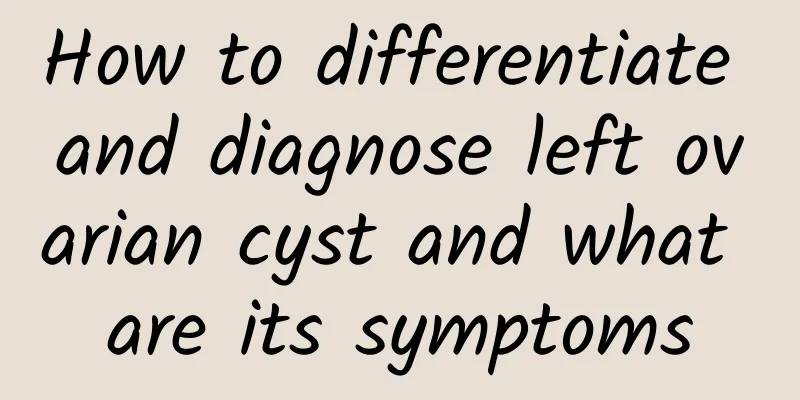How to differentiate and diagnose left ovarian cyst and what are its symptoms

|
Ovarian cyst is a relatively complicated disease in medicine. Because there are many causes, the symptoms are also different. So how to differentiate and diagnose left ovarian cyst? What are the symptoms? The left ovarian cyst is an ovarian tumor. The mortality rate of ovarian malignant tumors is relatively high, ranking first among gynecological tumors. Therefore, once it is confirmed to be a left ovarian cyst, it needs to be paid attention to. The symptoms of left ovarian cyst are as follows: 1. Discomfort in the lower abdomen: This is the initial symptom before the patient feels a mass in the lower abdomen. Due to the weight of the tumor itself and the influence of intestinal peristalsis and changes in body position, the tumor moves in the pelvic cavity, pulling on its pedicle and pelvic infundibulum ligament, causing the patient to have a feeling of distension and heaviness in the lower abdomen or iliac fossa. 2. Increased abdominal circumference and abdominal swelling: This is the most common complaint. Patients notice the enlargement of their abdomen when they realize that their clothes or belts seem tight, or they feel it occasionally in the morning, so they press their abdomen and find swelling in the abdomen and abdominal distension and discomfort. 3. Menstrual disorders: Generally, ovarian or even bilateral ovarian cysts do not cause menstrual disorders because they do not destroy all normal ovarian tissues. Some uterine bleeding is not endocrine or is caused by ovarian tumors that change the pelvic blood vessel distribution and cause endometrial congestion; or it is caused by ovarian malignant tumors directly metastasizing to the endometrium. Menstrual disorders caused by endocrine tumors are often combined with other secretory influences. 4. Infertility: The cause of infertility caused by ovarian cysts has yet to be determined. 5. Abdominal pain: If the tumor has no complications, there is very little pain. Malignant cysts often cause abdominal pain and leg pain, and the pain often causes patients to seek emergency treatment. 6. Compression symptoms: Huge ovarian tumors can cause dyspnea and palpitations due to compression of the diaphragm. Ovarian tumors combined with a large amount of ascites can also cause this symptom; but some ovarian tumor patients' dyspnea is caused by unilateral or bilateral pleural effusion; and it is often combined with ascites to form the so-called Meigs syndrome. |
<<: Do birth control pills cause menstrual irregularities?
Recommend
How effective is TCM in treating cervical erosion?
Traditional Chinese medicine is also a commonly u...
Can vaginal inflammation heal on its own?
Vaginitis generally refers to vaginitis, which is...
Several treatment methods for irregular menstruation that everyone needs to know
In real life, most female friends suffer from men...
How can women prevent cervical erosion completely and effectively?
Women with cervical erosion will have various sym...
What are the abortion pills and what are the dangers of abortion pills?
There are always some girls who fail to protect t...
Is pelvic effusion accompanied by abdominal pain?
Pelvic effusion is a common gynecological disease...
Super fat burning power! Using elastic bands to train muscle strength can burn 100 calories in 10 minutes
I took out the resistance band that I bought a lo...
The middle-aged population may face the crisis of sarcopenia! The secret weapon for muscle growth is…
According to statistics from the National Health ...
Vulvar leukoplakia cannot ignore the changes in the vulvar skin and mucous membranes
In addition to vulvar itching and changes in the ...
Can overeating relieve stress? 8 bad habits before bed that may trap you in a vicious cycle of binge eating
Busy modern people often eat to relieve stress du...
Is yoga suitable for you? Or Pilates? Understand the professional analysis at one glance!
There are two major schools of fitness, which one...
When do women usually go through menopause?
Women generally go through menopause between the ...
Nori is a "vegetable in the sea" and is very nutritious! Supplementing iron and calcium to have a good complexion, "this" is more abundant
The black and purple seaweed is known as the &quo...
What causes ovarian cysts
There are many theories about the causes of ovari...
What should you pay attention to after an abortion?
What should you pay attention to after an abortio...









